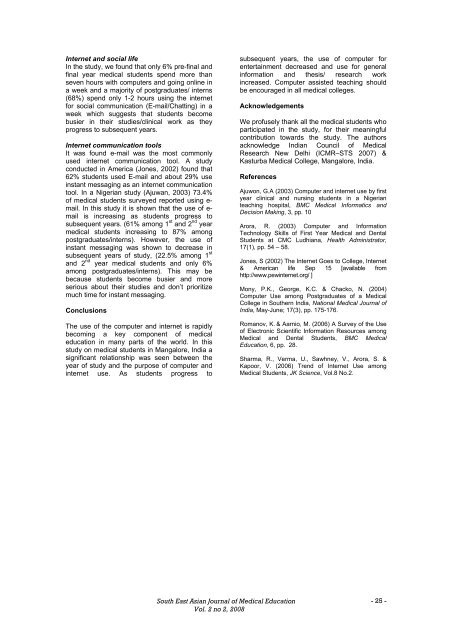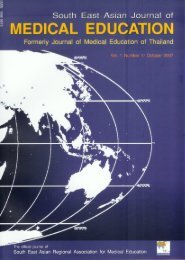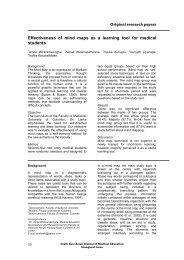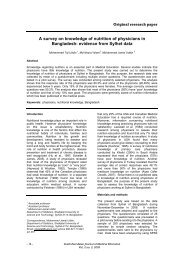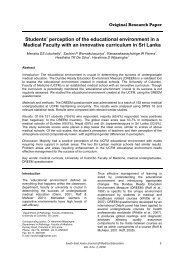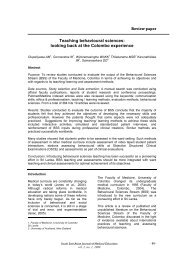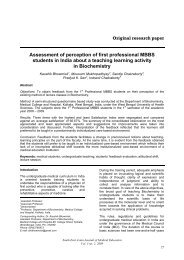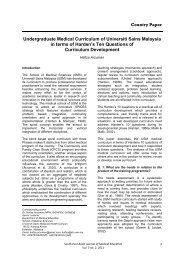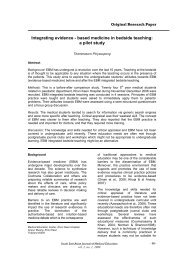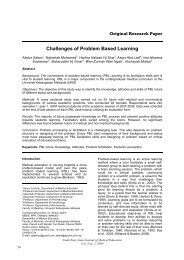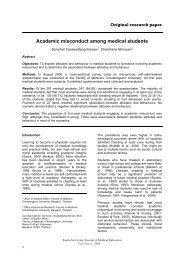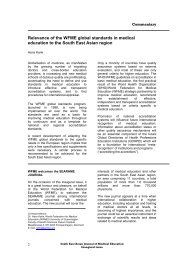Pattern of computer and internet use among medical students in ...
Pattern of computer and internet use among medical students in ...
Pattern of computer and internet use among medical students in ...
Create successful ePaper yourself
Turn your PDF publications into a flip-book with our unique Google optimized e-Paper software.
Internet <strong>and</strong> social lifeIn the study, we found that only 6% pre-f<strong>in</strong>al <strong>and</strong>f<strong>in</strong>al year <strong>medical</strong> <strong>students</strong> spend more thanseven hours with <strong>computer</strong>s <strong>and</strong> go<strong>in</strong>g onl<strong>in</strong>e <strong>in</strong>a week <strong>and</strong> a majority <strong>of</strong> postgraduates/ <strong>in</strong>terns(68%) spend only 1-2 hours us<strong>in</strong>g the <strong><strong>in</strong>ternet</strong>for social communication (E-mail/Chatt<strong>in</strong>g) <strong>in</strong> aweek which suggests that <strong>students</strong> becomebusier <strong>in</strong> their studies/cl<strong>in</strong>ical work as theyprogress to subsequent years.Internet communication toolsIt was found e-mail was the most commonly<strong>use</strong>d <strong><strong>in</strong>ternet</strong> communication tool. A studyconducted <strong>in</strong> America (Jones, 2002) found that62% <strong>students</strong> <strong>use</strong>d E-mail <strong>and</strong> about 29% <strong>use</strong><strong>in</strong>stant messag<strong>in</strong>g as an <strong><strong>in</strong>ternet</strong> communicationtool. In a Nigerian study (Ajuwan, 2003) 73.4%<strong>of</strong> <strong>medical</strong> <strong>students</strong> surveyed reported us<strong>in</strong>g e-mail. In this study it is shown that the <strong>use</strong> <strong>of</strong> e-mail is <strong>in</strong>creas<strong>in</strong>g as <strong>students</strong> progress tosubsequent years. (61% <strong>among</strong> 1 st <strong>and</strong> 2 nd year<strong>medical</strong> <strong>students</strong> <strong>in</strong>creas<strong>in</strong>g to 87% <strong>among</strong>postgraduates/<strong>in</strong>terns). However, the <strong>use</strong> <strong>of</strong><strong>in</strong>stant messag<strong>in</strong>g was shown to decrease <strong>in</strong>subsequent years <strong>of</strong> study, (22.5% <strong>among</strong> 1 st<strong>and</strong> 2 nd year <strong>medical</strong> <strong>students</strong> <strong>and</strong> only 6%<strong>among</strong> postgraduates/<strong>in</strong>terns). This may bebeca<strong>use</strong> <strong>students</strong> become busier <strong>and</strong> moreserious about their studies <strong>and</strong> don’t prioritizemuch time for <strong>in</strong>stant messag<strong>in</strong>g.ConclusionsThe <strong>use</strong> <strong>of</strong> the <strong>computer</strong> <strong>and</strong> <strong><strong>in</strong>ternet</strong> is rapidlybecom<strong>in</strong>g a key component <strong>of</strong> <strong>medical</strong>education <strong>in</strong> many parts <strong>of</strong> the world. In thisstudy on <strong>medical</strong> <strong>students</strong> <strong>in</strong> Mangalore, India asignificant relationship was seen between theyear <strong>of</strong> study <strong>and</strong> the purpose <strong>of</strong> <strong>computer</strong> <strong>and</strong><strong><strong>in</strong>ternet</strong> <strong>use</strong>. As <strong>students</strong> progress tosubsequent years, the <strong>use</strong> <strong>of</strong> <strong>computer</strong> forenterta<strong>in</strong>ment decreased <strong>and</strong> <strong>use</strong> for general<strong>in</strong>formation <strong>and</strong> thesis/ research work<strong>in</strong>creased. Computer assisted teach<strong>in</strong>g shouldbe encouraged <strong>in</strong> all <strong>medical</strong> colleges.AcknowledgementsWe pr<strong>of</strong><strong>use</strong>ly thank all the <strong>medical</strong> <strong>students</strong> whoparticipated <strong>in</strong> the study, for their mean<strong>in</strong>gfulcontribution towards the study. The authorsacknowledge Indian Council <strong>of</strong> MedicalResearch New Delhi (ICMR–STS 2007) &Kasturba Medical College, Mangalore, India.ReferencesAjuwon, G.A (2003) Computer <strong>and</strong> <strong><strong>in</strong>ternet</strong> <strong>use</strong> by firstyear cl<strong>in</strong>ical <strong>and</strong> nurs<strong>in</strong>g <strong>students</strong> <strong>in</strong> a Nigerianteach<strong>in</strong>g hospital, BMC Medical Informatics <strong>and</strong>Decision Mak<strong>in</strong>g, 3, pp. 10Arora, R. (2003) Computer <strong>and</strong> InformationTechnology Skills <strong>of</strong> First Year Medical <strong>and</strong> DentalStudents at CMC Ludhiana, Health Adm<strong>in</strong>istrator,17(1), pp. 54 – 58.Jones, S (2002) The Internet Goes to College, Internet& American life Sep 15 [available fromhttp://www.pew<strong><strong>in</strong>ternet</strong>.org/ ]Mony, P.K., George, K.C. & Chacko, N. (2004)Computer Use <strong>among</strong> Postgraduates <strong>of</strong> a MedicalCollege <strong>in</strong> Southern India, National Medical Journal <strong>of</strong>India, May-June; 17(3), pp. 175-176.Romanov, K. & Aarnio, M. (2006) A Survey <strong>of</strong> the Use<strong>of</strong> Electronic Scientific Information Resources <strong>among</strong>Medical <strong>and</strong> Dental Students, BMC MedicalEducation, 6, pp. 28.Sharma, R., Verma, U., Sawhney, V., Arora, S. &Kapoor, V. (2006) Trend <strong>of</strong> Internet Use <strong>among</strong>Medical Students, JK Science, Vol.8 No.2.South East Asian Journal <strong>of</strong> Medical EducationVol. 2 no 2, 2008- 25 -


